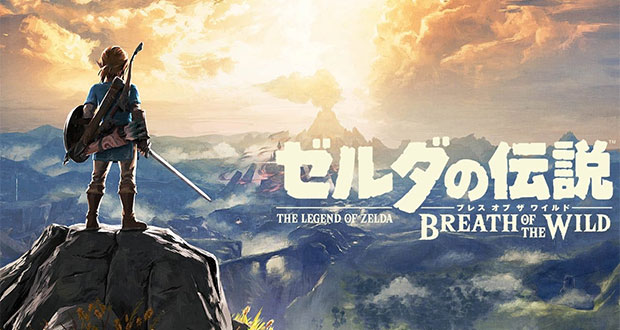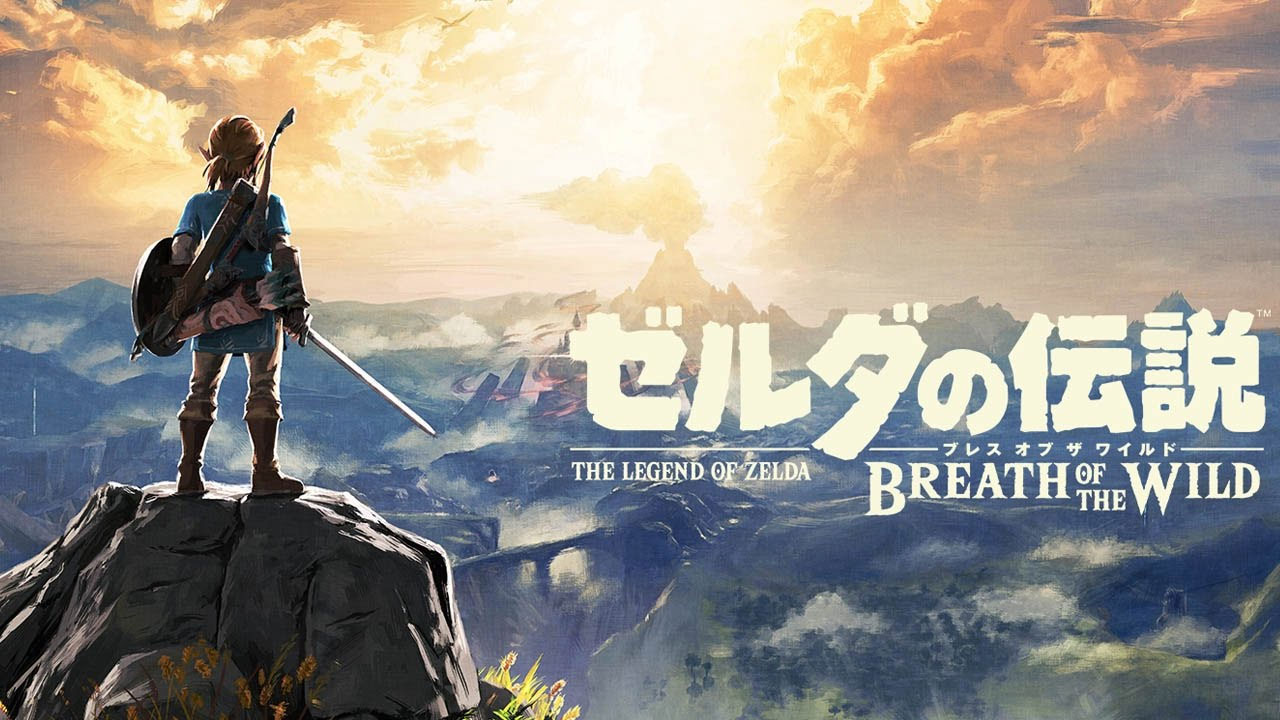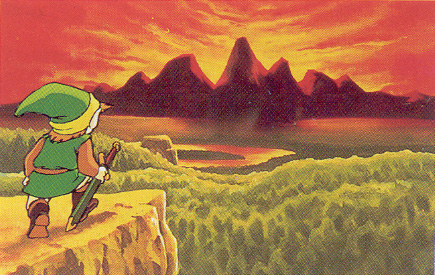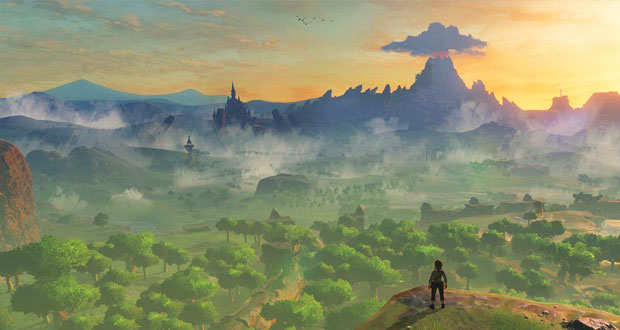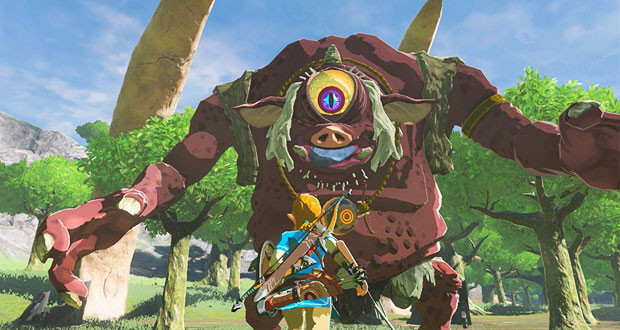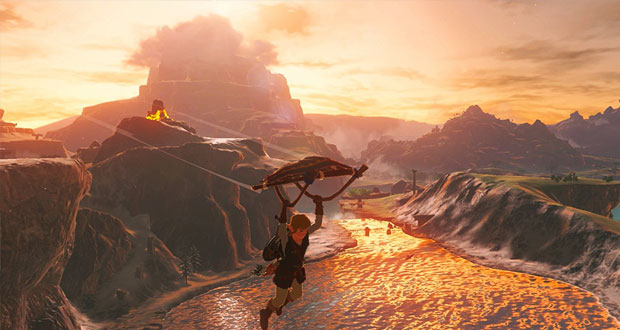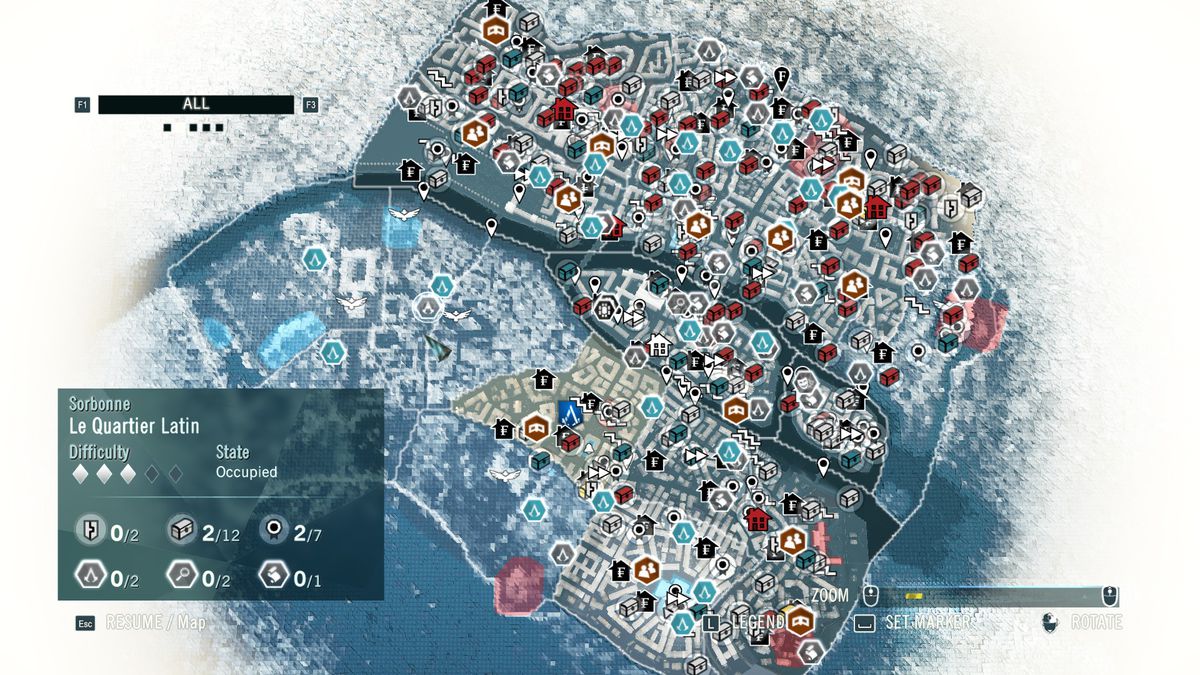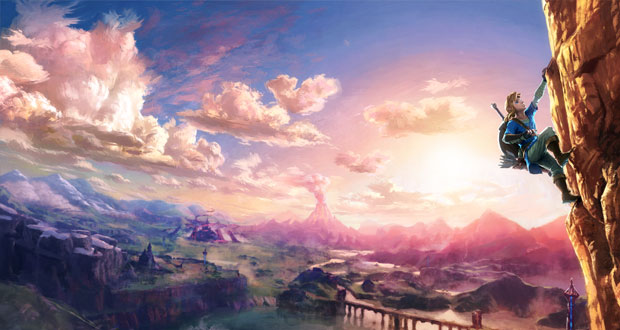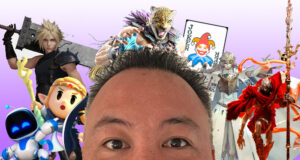Developer: Nintendo EPD
Publisher: Nintendo
Platform: Nintendo Switch
There’s a piece of concept art in the manual for The Legend of Zelda [1986, NES] that shows the hero Link standing at the precipice of a great plateau, overlooking a vast landscape. Ahead of him is a lush green forest bisected by a winding river and in the distance the ominous darkened peaks of an imposing mountain range. The image is wonderfully evocative and perfectly captures the sense of adventure and exploration that players would seek in a fantasy adventure game. Of course, despite being a classic of its time, due to technical constraints, the original Legend of Zelda doesn’t exactly realize that vision.
Future iterations in the series would also come to be regarded as classics in their own right but for the longest time, the Legend of Zelda games came to be defined by a series of distinctive templates and systems that each new release would rigidly adhere to. They were linear experiences with players unlocking access to each dungeon, each weapon and each new area in the same sequence as every other player before and after them.
It’s taken thirty one years and finally The Legend of Zelda: The Breath of the Wild is the game that makes good on bringing that original concept artwork to life. Not just in a literal sense (the player begins the game on that very plateau) but with its design philosophy, Breath of the Wild is an open ended adventure game that lets the players go in any direction, to do whatever they want, when they want. The result is breath-taking.
The paucity of tutorials and guides in the opening minutes of the game is a startling change from its predecessor Skyward Sword which literally guided the player with a firm hand through its opening seven or eight hours. I had read several previews about Breath of the Wild before I played it so I felt I knew what I getting myself into but there really is nothing like experiencing this game’s opening minutes first hand. Link wakes up from a hundred year slumber. He walks out of his dwelling and that’s the introduction over with. The entire world of Hyrule is at your feet and every players experience from that point forward will be different. There’s a hundred hours of exploration that awaits but equally, there is nothing stopping the player making a beeline straight for Calamity Ganon if they wish (the speedrun record of this game is an incredible 48 minutes).
Every player will have their own story of what they did first. Here’s mine. I ran around a field and climbed some trees. I tried to climb the side of a cliff but in the game’s early state Link can’t hold onto anything for very long so he fell to his death. Starting over, I approached a camp of moblins. I pushed a boulder at the top of a hill that rolled down and wiped out one of them like a sequence from a Looney Tunes cartoon. The others ran over to attack me. I killed one moblin but dropped my makeshift weapon (a stick) in the process. His friend stole my stick (!) and chased me with it. I picked up a sword that was lying around at the camp and used it to finish off the remaining moblins. But before I could get too attached to my new weapon, it fell to pieces as I landed the killer blow to the final creature. Afterwards, I ate the meat that was being cooked at the camp site and then a birdman standing on the roof of a dilapidated church steeple caught my eye so I scampered off to find a way to climb up and talk to him.
That unscripted mayhem in the opening moments of the game neatly encapsulates what Breath of the Wild is about from moment to moment and what makes it so good. The enemy AI reacts to your behavior in a wide variety of ways and often retaliates in comedic fashion. I’ve seen moblins run away when a fight doesn’t go their way. I’ve run away from moblins when I’ve been overrun and I can hear them laughing at me. Things have accidentally exploded in the heat of battle sending people flying through the air. I’ve seen a hinox pick up a tree and swing it at me, only to accidentally wipe out his smaller friends at his feet. I’ve even seen a beefy Lizalfos pick up a smaller bokoblin and toss it at me as a weapon! Even at the seventy hour mark in the game, I was still coming across new ways to defeat enemies (e.g. leaving metal swords near sleeping mokoblins in a thunder storm) and seeing new behaviors from creatures in how they attacked me (the Lynels are especially devious).
Basic survival is an ongoing challenge in Breath of the Wild, an unexpected curveball from a series that has been known for rather milquetoast difficulty. Be prepare to die a lot in this game. It’s easy to wander into an area where the creatures are far stronger than you and can fell you with a single hit. Likewise the scorching heat of Gerudo Town and the brutal chills near the Keh Namut shrine can also kill Link unless he is prepared with the right clothing or food. Every weapon and shield in the game is breakable over time so its impossible to get too comfortable. It’s a constant requirement to find new loot and cook up new dishes and elixirs to navigate the more challenging corners of Hyrule. It’s a brilliant new wrinkle to the series.
Of course the heightened difficulty and stack of new challenges would make for a frustrating game were it not for the outstanding new play mechanics that Breath of the Wild has to offer. The controls on the Switch, particularly with the Pro Controller, are absolutely butter smooth. The way Link handles and the range of new moves in his arsenal also represents a significant step change for the series. This is the first Zelda game where Link can jump (!). This might sound like a revelation but in actuality, it is two other manoveurs – the ability to glide and climb – that radically changes the game for the better.
The glider, picked up early on at the Great Plateau, makes soaring through the open world an absolute pleasure. Its speedy, easy to handle and is so convenient that it greatly discourages the player from simply fast travelling all over the place as the glider lets you absorb your surroundings and quickly change direction when something interesting catches your eye (which is basically all the time).
Secondly, there’s climbing. In Breath of the Wild, Link can climb over most surfaces to the extent that his stamina meter will allow him (think of the radial dial from Shadow of the Colossus). There have been plenty of games before Breath of the Wild that allows the player to climb but I can think of few open world games that allow you to do so on practically any surface and succeed in making it a fun challenge by forcing the player to negotiate their stamina meter with finding an outlying ledge to rest on. In the likes of Uncharted and Assassin’s Creed, climbing represents some of the least interesting elements of these respective games as the player simply holds up on their controller and waits for the animation to complete. In Zelda, its part of what makes exploring so much fun.
Combat is also improved with the addition of time-sensitive dodge and parry moves that, when employed correctly, slows time and allows Link to get in a flurry of extra hits. Mastery of both dodging and parrying is essential to besting some of the games trickier enemies such as the Guardians and the Lynels.
The sense of discovery that Breath of the Wild instils in the player is something that has been missing from the majority of games in the open world genre for some time.
The Hyrule that awaits the player in Breath of the Wild is filled with a jaw-dropping variety of landscapes – snowy, tropical, desert, forest, mountainous, open pastures – and that terrain is populated with a huge number of villages, wild life, hostile creatures and over one hundred subterranean shrines to be explored. There are so many spectacular sights that initially appear as a dot on the horizon (“is that a pillar of smoke in the forest?”, “is that a flying dragon at the top of that mountain?”, “is that a giant troll sleeping with treasure on its chest?”) that grabs your attention and lures you in for the next adventure.
The old open-world RPG cliche went something like this – “see that mountain in the distance? You can go there!” It’s true, but its likely that you’ll get there with a GPS path-finding route that you and everyone else follows in the same way. Breath of the Wild has no such feature and it is all the better for it. So how are you going to get to that mountain? You’ll have to decide if you want to chop down a tree and make a bridge out of it. Or glide over a ravine and hope you have enough stamina to climb the other side. Or head East and see if you can make it past the bandit camp. The choice is yours.
The game does have an open world staple in the form of towers that must be climbed to unlock new areas on the map (popularized by Assassin’s Creed) but instead of cramming the map full of side quest markers, the player must instead take out their telescope and find points of interest for themselves which you manually mark on your map. Instead of feeling like a step backward, this Do It Yourself ethos feels refreshing and far more invigorating when motivating players to actually explore their environment.
Breath of the Wild’s primary form of content comes in the form of shrines – miniature dungeons which contain either a Guardian to defeat or a puzzle to solve that typically takes 5-10 minutes. These shrines reminded me a lot of Valve’s classic puzzles game Portal, both in the playfulness of the design and the neon blue aesthetic. As part of the staple content of the game, I found them to be an order of magnitude more interesting to negotiate than the endless fetch quests and collectathons that pass for things to do in similar open world games.
The other aspect of Breath of the Wild that continued to impress me was the sheer number of imaginative spectacles the game has to offer that are completely independent of being quest content. Without wishing to spoil too much, the game memorably lets you go sand-seal surfing, ride a wild stag and discover a location called Eventide Island which momentarily turns the game into a mini rogue-like where Link must gather all the treasure on the island with just a single life and without the use of any weapons. The game is just packed with these sort of passages of play that are creatively designed and a treat to play through.
Breath of the Wild is a game of extraordinary depth. A cursory glance at the game’s online community reveals Youtube videos with titles like ‘one hundred secrets you may not have discovered’ or ‘fifty things you may have missed’. Underpinning this embarrassment of riches in a labyrinthine chain of systems that fuse the game together. There is a day/night cycle. A weather cycle. An elemental system where everything flammable can be set on fire and everything metal can conduct electricity. There is a cooking system that lets the player experiment and create over a hundred dishes. There are AI systems that determine which wildlife are docile to Link and which are not. Weapons can be crafted and improved. Trees can be chopped down, turned into kindling or used as a weapon. Houses can be purchased and furnished. Dogs can be fed and befriended. And on and on and on. There is just a mind-boggling variety of mechanisms that make the gears turn in this game and incredibly, at the end of it all, Nintendo have held their nerve and explained almost none of it to the player. It is all there to be discovered for themselves in a way that feels organic and spontaneous.
Amongst this myriad of distractions is of course, the nineteenth story of a hero named Link who is preordained to find the Master Sword, befriend Princess Zelda and challenge the villainous Ganon. In a revolutionary new Zelda game that has thrown out so many longstanding conventions, the narrative in Breath of the Wild is merely ‘good’. In creating such an open ended game, there is a challenge telling the story as different chapters will be encountered in a different order by every player. So the slices of story are broken up like jigsaw pieces and unlocked as ‘Memories’ which are scattered throughout the game. While Breath of the Wild stops shy of doing anything truly radical (there is a growing chorus of voices who wish for Zelda to be the hero of the story), there is still an entertaining tale that is told.
I could go on about Breath of the Wild. I have barely spoken about the game’s art style. Or its ambient soundtrack. Or the matriarchal Gerudo Town which only allows women. Or the four ‘real’ dungeons – the Divine Beasts – each of which resembles an enormous animal. But these are all aspects of the game best enjoyed unspoiled and experienced first hand.
Not only after the release of Skyward Sword, Legend of Zelda‘s custodian Eiji Aonuma gave several interviews where he acknowledged a stagnancy that had crept into the Zelda franchise and a need for the game to modernize. With Breath of the Wild, creative director Hidemaro Fujibayashi and his team have delivered on that goal. The game is an instant classic and unless there is an unparalleled backlash coming in the months ahead, they seem to have finally made a game more beloved than 1998’s Legend of Zelda: Ocarina of Time. It is a game so well constructed that I expect it will influence countless games that follow it. It is a crucial launch title for the Switch, a system that Nintendo cannot afford to have fail. And it is a game that gives great optimism to any fan of Nintendo themselves. If they can successfully breath new life into one of their oldest and most conservative franchises with such innovative and modern concepts, what else could they achieve. What does the future hold for Super Mario, Metroid, Animal Crossing and their other series? Time will tell and provide some added perspective but on first instinct, Breath of the Wild feels like the most significant game that Nintendo has made in two decades, sitting squarely shoulder to shoulder with Super Mario Bros and Super Mario 64.
Review Overview
RATING
CLASSIC
Summary : An instant classic that may single-handedly kickstart the fortunes of the Nintendo Switch and change how players and game developers think of open world games
 The FAT Website est. 1999
The FAT Website est. 1999

